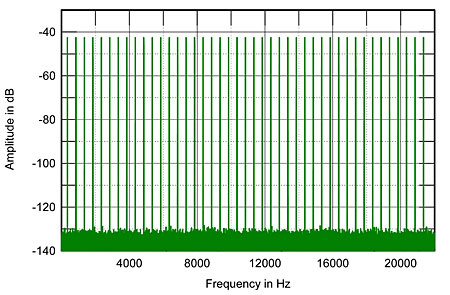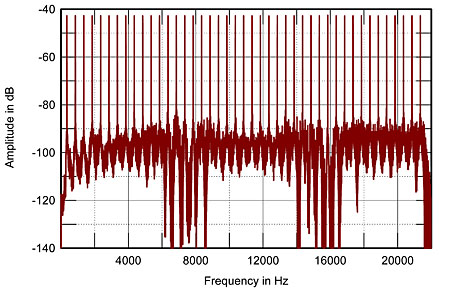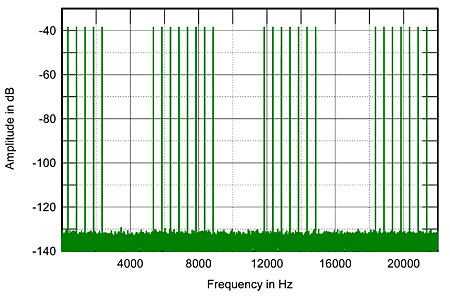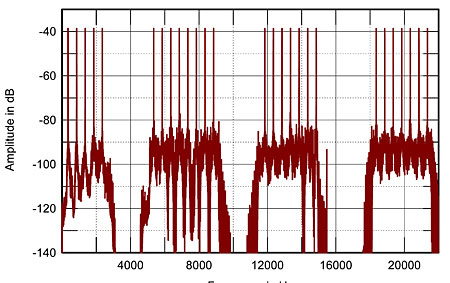-
WANTED: Happy members who like to discuss audio and other topics related to our interest. Desire to learn and share knowledge of science required. There are many reviews of audio hardware and expert members to help answer your questions. Click here to have your audio equipment measured for free!
- Forums
- Audio, Audio, Audio!
- DACs, Streamers, Servers, Players, Audio Interface
- Digital To Analog (DAC) Reviews and Discussion
You are using an out of date browser. It may not display this or other websites correctly.
You should upgrade or use an alternative browser.
You should upgrade or use an alternative browser.
High Resolution Audio?
- Thread starter W2S
- Start date
- Joined
- Feb 5, 2019
- Messages
- 3,688
- Likes
- 4,069
What about this "listening fatigue", at the end of the day?
Fast or impression ?
By the way, anybody took this test?
https://www.npr.org/sections/therec...ll-can-you-hear-audio-quality?t=1550584113462
Each time there's a 128 kbps mp3, a 320 kbps mp3 and a WAV. You have to choose the one you think sounds best.
With my desktop IEM, I chose the WAV twice, the 320 once, and the 128 three times!! :-(
Fast or impression ?
By the way, anybody took this test?
https://www.npr.org/sections/therec...ll-can-you-hear-audio-quality?t=1550584113462
Each time there's a 128 kbps mp3, a 320 kbps mp3 and a WAV. You have to choose the one you think sounds best.
With my desktop IEM, I chose the WAV twice, the 320 once, and the 128 three times!! :-(
Last edited:
What about this "listening fatigue", at the end of the day?
Fast or impression ?
By the way, anybody took this test?
https://www.npr.org/sections/therec...ll-can-you-hear-audio-quality?t=1550584113462
Each time there's a 128 kbps mp3, a 320 kbps mp3 and a WAV. You have to choose the one you think sounds best.
With my desktop IEM, I chose the WAV twice, the 320 once, and the 128 three times!! :-(
Using a custom Dac/Amp+Meze99 Classic(with a sheepskin Brainwavz earpads,better highs and tighter bass after 1-2 months the pads get softer/used,but i bought it for comfort)I was a little fast on the last one,Coldplay.I tought i heard something for sure... 4xWAV 2x320mp3.Even after i know the answer for the Suzanne Vega,i still couldn't hear the difference.I think 6 sample is too small.
Degru
Active Member
I got 4 out of 6 on that test, and the two I got wrong I picked 320k MP3. The mistakes were the Mozart and Neil Young tracks. Mozart because it's a relatively simple track with a relatively high noise floor, and Neil Young because there was some congestion in the mixing/mastering of the instrumentals that masked the MP3 compression.
I didn't pay that much attention throughout the test, mostly just listening through the tracks for a brief moment and picking the one that sounded best off the top of my head. Upon closer listening, I can definitely hear some of the signs of MP3 compression on the 320k versions of the two tracks I got wrong, though they wouldn't bother me during regular listening if I didn't know which was which. Coldplay jumped out to me immediately and I think I spent less than 5 seconds clicking through the samples before it was obvious which was the lossless.
My setup is just HD600 out of a Latitude E5400 headphone jack, which is a laptop from 2008 I've got better source gear but like to use this for codec tests just so they carry more weight...
I've got better source gear but like to use this for codec tests just so they carry more weight...
I've gotten 10/10 on an ABX test of FLAC vs 320k MP3 on a well mastered metal track with this setup before.
As for hi res audio, have never been able to hear the difference with any gear. The only exception is DSD, where I noticed it sounded a slight bit warmer than the PCM version, and that's it. But a slight boost in the low frequencies doesn't exactly say anything about hi res.
I didn't pay that much attention throughout the test, mostly just listening through the tracks for a brief moment and picking the one that sounded best off the top of my head. Upon closer listening, I can definitely hear some of the signs of MP3 compression on the 320k versions of the two tracks I got wrong, though they wouldn't bother me during regular listening if I didn't know which was which. Coldplay jumped out to me immediately and I think I spent less than 5 seconds clicking through the samples before it was obvious which was the lossless.
My setup is just HD600 out of a Latitude E5400 headphone jack, which is a laptop from 2008
I've gotten 10/10 on an ABX test of FLAC vs 320k MP3 on a well mastered metal track with this setup before.
As for hi res audio, have never been able to hear the difference with any gear. The only exception is DSD, where I noticed it sounded a slight bit warmer than the PCM version, and that's it. But a slight boost in the low frequencies doesn't exactly say anything about hi res.
Last edited:
Degru
Active Member
I suppose I may as well share my findings on comparing different lossy codecs.
MP3 compression to me is audible in most cases, even at 320k. I'm not usually bothered by it, but if I'm listening out of a good source in a quiet room, I can't unhear it when I notice it. It's most evident on well mastered dynamic tracks with a low noise floor, and especially on things like metal where there is a lot of different textures to the audio.
AAC compression sounds somewhat similar to MP3, just a lot less audible. I cannot notice any compression on well encoded 256k AAC at all. The main downfall of the codec is the encoders available. The only good one I've found is Apple's encoder built into macOS and iTunes, and maybe the FFMPEG 3.0 encoder though I haven't done much testing with that. Apple's encoder is quite annoying to use through qaac because there aren't any conversion programs with it integrated, and likewise there are few dedicated bulk audio conversion programs utilizing FFMPEG 3.0. So, great codec if you're an Apple user, but a pain to find good encoders on other platforms.
OGG is what Spotify uses, though Spotify certainly isn't the best example. They seem to have either bad masters or bad encodings of some of their tracks, which is probably where a lot of the complaints come from. The compression artifacts from this codec are less obvious than MP3, and the track generally starts sounding a bit muddier as you lower the bitrate without the obvious artifacts in the highs that you get with MP3. It's also a free codec with ample well documented encoders available, though it suffers from lack of support on dedicated audio player devices.
OPUS is thus far THE best lossy codec I have heard. Its compression has the same sort of audible effect as OGG's in that it makes the track a bit less detailed and more congested as you go lower, except it is a LOT less audible, to the point that I don't notice significant degradation with ~128k encoded tracks. If I didn't have access to the original lossless, you could probably convince me that's just what the track itself sounds like. It's THAT good. The main downsides are support; I haven't seen anything common outside of Android and computers that play it. Another weird thing is that it will always output 48khz files, which isn't really ideal for playing back in Windows without WASAPI or ASIO. I keep the audio settings at 44100khz to eliminate resampling for most audio, so all OPUS tracks would go through the resampler which does introduce audible degradation.
MP3 compression to me is audible in most cases, even at 320k. I'm not usually bothered by it, but if I'm listening out of a good source in a quiet room, I can't unhear it when I notice it. It's most evident on well mastered dynamic tracks with a low noise floor, and especially on things like metal where there is a lot of different textures to the audio.
AAC compression sounds somewhat similar to MP3, just a lot less audible. I cannot notice any compression on well encoded 256k AAC at all. The main downfall of the codec is the encoders available. The only good one I've found is Apple's encoder built into macOS and iTunes, and maybe the FFMPEG 3.0 encoder though I haven't done much testing with that. Apple's encoder is quite annoying to use through qaac because there aren't any conversion programs with it integrated, and likewise there are few dedicated bulk audio conversion programs utilizing FFMPEG 3.0. So, great codec if you're an Apple user, but a pain to find good encoders on other platforms.
OGG is what Spotify uses, though Spotify certainly isn't the best example. They seem to have either bad masters or bad encodings of some of their tracks, which is probably where a lot of the complaints come from. The compression artifacts from this codec are less obvious than MP3, and the track generally starts sounding a bit muddier as you lower the bitrate without the obvious artifacts in the highs that you get with MP3. It's also a free codec with ample well documented encoders available, though it suffers from lack of support on dedicated audio player devices.
OPUS is thus far THE best lossy codec I have heard. Its compression has the same sort of audible effect as OGG's in that it makes the track a bit less detailed and more congested as you go lower, except it is a LOT less audible, to the point that I don't notice significant degradation with ~128k encoded tracks. If I didn't have access to the original lossless, you could probably convince me that's just what the track itself sounds like. It's THAT good. The main downsides are support; I haven't seen anything common outside of Android and computers that play it. Another weird thing is that it will always output 48khz files, which isn't really ideal for playing back in Windows without WASAPI or ASIO. I keep the audio settings at 44100khz to eliminate resampling for most audio, so all OPUS tracks would go through the resampler which does introduce audible degradation.
[...]Nothing recorded analog ever needs more than 16 bits, period!
Definitely my ears will not make a difference here, that's for sure, but some of us might start asking how many harmonics and added sounds are within a...whisper? Can we count them? I guess not, so that make them an infinite number., right? So how do we represent in audio-field an infinite number of sounds per second?
Worth a watch:
After all, nobody can count all the sounds involved in the audio spectrum of a song, so maybe there are some audiophiles out there, or even musicians, that can actually feel the songs in a different way (I'm not one of them, unfortunately).
My personal thoughts are that 24-bit audio will helps us in not loosing dynamics audio informations from a recording done at...let's say -3dB or even lower. Also, 32-bit DACs are good because these have a 32-bit internal volume control built-in. I'm aware that a 16-bit "-0.5dB peaks" recording will, most likely, sound identical with a 24-bit recording and in an A/B test I will simply can't point out the 16-bit and the 24-bit recording.
I think that MP3 is one of the most unfairly maligned technologies in audio. Those promoting high res and vinyl and shill reviewers have done an excellent job to convince many that MP3 is evil and that it kills music. The reality is that the people who developed MP3 did a brilliant job of splashing the memory needed to store music with very little compromise in audio quality. I find that the difference between 320k MP3 and RBCD and FLAC is very subtle and that on most recordings there is no difference in the listening experience (and BTW, I find no audible benefit from going beyond RBCD unless exploiting multi channel and surround sound options of high res). In the days when memory was expensive the much smaller file size of MP3 was hugely beneficial and a massive factor in the shift to computer audio.
- Joined
- Jun 19, 2018
- Messages
- 6,652
- Likes
- 9,406
I think that MP3 is one of the most unfairly maligned technologies in audio. Those promoting high res and vinyl and shill reviewers have done an excellent job to convince many that MP3 is evil and that it kills music. The reality is that the people who developed MP3 did a brilliant job of splashing the memory needed to store music with very little compromise in audio quality. I find that the difference between 320k MP3 and RBCD and FLAC is very subtle and that on most recordings there is no difference in the listening experience (and BTW, I find no audible benefit from going beyond RBCD unless exploiting multi channel and surround sound options of high res). In the days when memory was expensive the much smaller file size of MP3 was hugely beneficial and a massive factor in the shift to computer audio.
Couldn't agree more. Although now redundant, mp3 was an extremely clever meeting of psychoacoustics and engineering.
Couldn't agree more. Although now redundant, mp3 was an extremely clever meeting of psychoacoustics and engineering.
I despised early mp3 when it was using a mechanism called "joint stereo", not only compressed like modern MP3 but this feature neutered the stereo imaging.
I don't think I like the overall legacy that MP3 left on music, an entire generation that heard cymbals and high end freq and thought it was aluminium foil, I also think the advent of MP3 lead to the loudness wars that have leaked onto other formats.
I'm glad we live in a world of high speed internet and cheap storage so we have no need for MP3
For AAC on Windows - get Foobar2k and install iTunes. It will simply work.
Opus is the worst of 3 codecs - it cuts both low and high freqs, plus it reencodes to 48KHz - try any good guitar composition in FLAC and then encode to Opus. Opus was developed for voice encoding, not for music.
My ranking - Opus<Ogg<Mp3<<AAC<<FLAC
Opus is the worst of 3 codecs - it cuts both low and high freqs, plus it reencodes to 48KHz - try any good guitar composition in FLAC and then encode to Opus. Opus was developed for voice encoding, not for music.
My ranking - Opus<Ogg<Mp3<<AAC<<FLAC
AAC compression sounds somewhat similar to MP3, just a lot less audible. I cannot notice any compression on well encoded 256k AAC at all. The main downfall of the codec is the encoders available..
I think you may be misremembering. MP3 has three ways of encoding stereo data: left/right, mid/side, and intensity stereo. Joint stereo is a collective term for mid/side and intensity stereo.I despised early mp3 when it was using a mechanism called "joint stereo", not only compressed like modern MP3 but this feature neutered the stereo imaging.
The mid/side mode simply encodes the sum and difference of the left/right channels. This is more efficient than coding them separately since the difference is typically small, thus requiring fewer bits to achieve the same quality. Intensity stereo uses a single channel and specifies for each frequency band one of 7 positions from left to right. This method is typically only used for frequencies above some cut-off decided based on content and target bit rate.
Apart from being more efficient, mid/side mode has the advantage of better preserving the phase relationship between the channels. In left/right mode, nothing prevents the relative phase from wandering, and this can cause an unsteady stereo image.
Applying intensity stereo at too low frequencies makes the stereo image less well defined. Perhaps this is what you recall.
Degru
Active Member
For AAC on Windows - get Foobar2k and install iTunes. It will simply work.
Opus is the worst of 3 codecs - it cuts both low and high freqs, plus it reencodes to 48KHz - try any good guitar composition in FLAC and then encode to Opus. Opus was developed for voice encoding, not for music.
My ranking - Opus<Ogg<Mp3<<AAC<<FLAC
I transcoded a whole bunch of my music to 128k Opus and hardly noticed a difference when I did my testing, at least not *nearly* to the same extent as MP3, OGG, and even AAC.. It does sound like it somewhat cuts the extremes, but what's in between is a lot more transparent than other codecs at that bitrate. I wouldn't use it unless I really really needed that extra space on a mobile device, but it's certainly an impressive codec. It also rated consistently the highest on hydrogenaudio listening tests.
Thanks for the tip on foobar, I did not know that.
maty
Major Contributor
Year: 2012
MP3 vs AAC vs FLAC vs CD Page 2
https://www.stereophile.com/content/mp3-vs-aac-vs-flac-vs-cd-page-2

Fig.3 Spectrum of 500Hz-spaced multitone signal at –10dBFS, 16-bit linear PCM encoding (linear frequency scale, 10dB/vertical div.).

Fig.7 Spectrum of 500Hz-spaced multitone signal at –10dBFS, MP3 encoding at 320kbps (linear frequency scale, 10dB/vertical div.).

Fig.9 Spectrum of multitone signal with frequency gaps at –10dBFS, 16-bit linear PCM encoding (linear frequency scale, 10dB/vertical div.).

Fig.10 Spectrum of multitone signal with frequency gaps at –10dBFS, MP3 encoding at 320kbps (linear frequency scale, 10dB/vertical div.).
With decent recordings it is very easy to differentiate between MP3 320kbps (LAME) and FLAC 16/44. If it is not the case, it is that you have a bottleneck in your system that prevents it.
MP3 vs AAC vs FLAC vs CD Page 2
https://www.stereophile.com/content/mp3-vs-aac-vs-flac-vs-cd-page-2

Fig.3 Spectrum of 500Hz-spaced multitone signal at –10dBFS, 16-bit linear PCM encoding (linear frequency scale, 10dB/vertical div.).

Fig.7 Spectrum of 500Hz-spaced multitone signal at –10dBFS, MP3 encoding at 320kbps (linear frequency scale, 10dB/vertical div.).

Fig.9 Spectrum of multitone signal with frequency gaps at –10dBFS, 16-bit linear PCM encoding (linear frequency scale, 10dB/vertical div.).

Fig.10 Spectrum of multitone signal with frequency gaps at –10dBFS, MP3 encoding at 320kbps (linear frequency scale, 10dB/vertical div.).
With decent recordings it is very easy to differentiate between MP3 320kbps (LAME) and FLAC 16/44. If it is not the case, it is that you have a bottleneck in your system that prevents it.
- Joined
- Jun 19, 2018
- Messages
- 6,652
- Likes
- 9,406
Year: 2012
MP3 vs AAC vs FLAC vs CD Page 2
https://www.stereophile.com/content/mp3-vs-aac-vs-flac-vs-cd-page-2

Fig.3 Spectrum of 500Hz-spaced multitone signal at –10dBFS, 16-bit linear PCM encoding (linear frequency scale, 10dB/vertical div.).

Fig.7 Spectrum of 500Hz-spaced multitone signal at –10dBFS, MP3 encoding at 320kbps (linear frequency scale, 10dB/vertical div.).

Fig.9 Spectrum of multitone signal with frequency gaps at –10dBFS, 16-bit linear PCM encoding (linear frequency scale, 10dB/vertical div.).

Fig.10 Spectrum of multitone signal with frequency gaps at –10dBFS, MP3 encoding at 320kbps (linear frequency scale, 10dB/vertical div.).
With decent recordings it is very easy to differentiate between MP3 320kbps (LAME) and FLAC 16/44. If it is not the case, it is that you have a bottleneck in your system that prevents it.
If you are listening at 80dB, all the noise and distortion shown in those graphs is below the absolute threshold of audibility, even in quiet. If you are listening above 80dB, all or most of it is likely to be masked by the signal (depending on what the signal is).
Have you tried an ABX test of 320kbps MP3 and WAV? Not many have passed one, although it is possible.
maty
Major Contributor
March, 2011
I wrote about WAV and FLAC [0, 1024kbps] versus MP3 [Lame, 320kbps].
CD ripped: Bela Fleck & The Flecktones: New South Africa (1996) with EAC v1.0 beta 1

And it was a second system much worse than the current one!
I wrote about WAV and FLAC [0, 1024kbps] versus MP3 [Lame, 320kbps].
CD ripped: Bela Fleck & The Flecktones: New South Africa (1996) with EAC v1.0 beta 1

And it was a second system much worse than the current one!
- Joined
- Jun 19, 2018
- Messages
- 6,652
- Likes
- 9,406
March, 2011
I wrote about WAV and FLAC [0, 1024kbps] versus MP3 [Lame, 320kbps].
CD ripped: Bela Fleck & The Flecktones: New South Africa (1996) with EAC v1.0 beta 1

And it was a second system much worse than the current one!
How many trials did you do and how many did you get correct?
maty
Major Contributor
Bela Fleck & the Flecktones - Live Art (1996)
https://www.discogs.com/Béla-Fleck-The-Flecktones-Live-Art/release/1401312
https://www.amazon.com/Live-Art-Bela-Fleck-Flecktones/dp/B000002N7R
:format(jpeg):mode_rgb():quality(90)/discogs-images/R-1401312-1504498583-2364.jpeg.jpg)
DR Peak RMS Duration Track
--------------------------------------------------------------------------------
DR13 -2.51 dB -23.69 dB 0:39 01-Intro
DR10 -0.24 dB -12.05 dB 4:43 02-New South Africa
DR11 -0.30 dB -14.57 dB 5:26 03-Stomping Grounds
DR10 -0.27 dB -13.03 dB 5:46 04-Lochs of Dread
DR12 -0.33 dB -15.37 dB 7:33 05-Bigfoot
DR11 -0.26 dB -14.61 dB 7:21 06-Far East Medley
DR11 -0.37 dB -14.36 dB 5:35 07-Flying Saucer Dudes
DR11 -0.21 dB -14.43 dB 3:38 08-UFO Tofu
DR14 -0.37 dB -19.79 dB 3:06 09-Interlude-Libation, The Water Ritual
DR12 -0.34 dB -14.10 dB 6:02 10-Vix 9
DR12 -0.30 dB -16.22 dB 9:14 11-The Message
--------------------------------------------------------------------------------
Number of tracks: 11
Official DR value: DR12
DR Peak RMS Duration Track
--------------------------------------------------------------------------------
DR14 -0.48 dB -17.84 dB 6:47 01-Amazing Grace
DR12 -0.44 dB -15.43 dB 4:40 02-Shubbee's Doobie
DR10 -0.46 dB -13.46 dB 6:21 03-Oh Darling
DR11 -0.44 dB -14.34 dB 7:36 04-Blu-Bop
DR13 -0.35 dB -17.31 dB 5:56 05-Sunset Road
DR11 -0.37 dB -15.96 dB 7:43 06-More Luv
DR14 -0.92 dB -18.92 dB 6:09 07-Bach / The Ballad of Jed Clampett
DR12 -0.40 dB -14.32 dB 5:38 08-Cheeseballs In Cowtown
DR10 -0.29 dB -13.31 dB 7:30 09-The Sinister Minister
DR14 -0.32 dB -19.86 dB 4:53 10-Flight of the Cosmic Hippo
--------------------------------------------------------------------------------
Number of tracks: 10
Official DR value: DR12
https://www.discogs.com/Béla-Fleck-The-Flecktones-Live-Art/release/1401312
https://www.amazon.com/Live-Art-Bela-Fleck-Flecktones/dp/B000002N7R
:format(jpeg):mode_rgb():quality(90)/discogs-images/R-1401312-1504498583-2364.jpeg.jpg)
DR Peak RMS Duration Track
--------------------------------------------------------------------------------
DR13 -2.51 dB -23.69 dB 0:39 01-Intro
DR10 -0.24 dB -12.05 dB 4:43 02-New South Africa
DR11 -0.30 dB -14.57 dB 5:26 03-Stomping Grounds
DR10 -0.27 dB -13.03 dB 5:46 04-Lochs of Dread
DR12 -0.33 dB -15.37 dB 7:33 05-Bigfoot
DR11 -0.26 dB -14.61 dB 7:21 06-Far East Medley
DR11 -0.37 dB -14.36 dB 5:35 07-Flying Saucer Dudes
DR11 -0.21 dB -14.43 dB 3:38 08-UFO Tofu
DR14 -0.37 dB -19.79 dB 3:06 09-Interlude-Libation, The Water Ritual
DR12 -0.34 dB -14.10 dB 6:02 10-Vix 9
DR12 -0.30 dB -16.22 dB 9:14 11-The Message
--------------------------------------------------------------------------------
Number of tracks: 11
Official DR value: DR12
DR Peak RMS Duration Track
--------------------------------------------------------------------------------
DR14 -0.48 dB -17.84 dB 6:47 01-Amazing Grace
DR12 -0.44 dB -15.43 dB 4:40 02-Shubbee's Doobie
DR10 -0.46 dB -13.46 dB 6:21 03-Oh Darling
DR11 -0.44 dB -14.34 dB 7:36 04-Blu-Bop
DR13 -0.35 dB -17.31 dB 5:56 05-Sunset Road
DR11 -0.37 dB -15.96 dB 7:43 06-More Luv
DR14 -0.92 dB -18.92 dB 6:09 07-Bach / The Ballad of Jed Clampett
DR12 -0.40 dB -14.32 dB 5:38 08-Cheeseballs In Cowtown
DR10 -0.29 dB -13.31 dB 7:30 09-The Sinister Minister
DR14 -0.32 dB -19.86 dB 4:53 10-Flight of the Cosmic Hippo
--------------------------------------------------------------------------------
Number of tracks: 10
Official DR value: DR12
Last edited:
maty
Major Contributor
The difference WAV and FLAC was so obvious versus MP3 that there was no need to repeat. Very obvious to anyone!
Similar threads
- Replies
- 10
- Views
- 827
- Replies
- 5
- Views
- 615
- Replies
- 159
- Views
- 10K
- Replies
- 7
- Views
- 694
